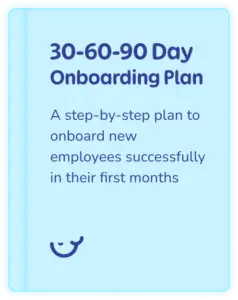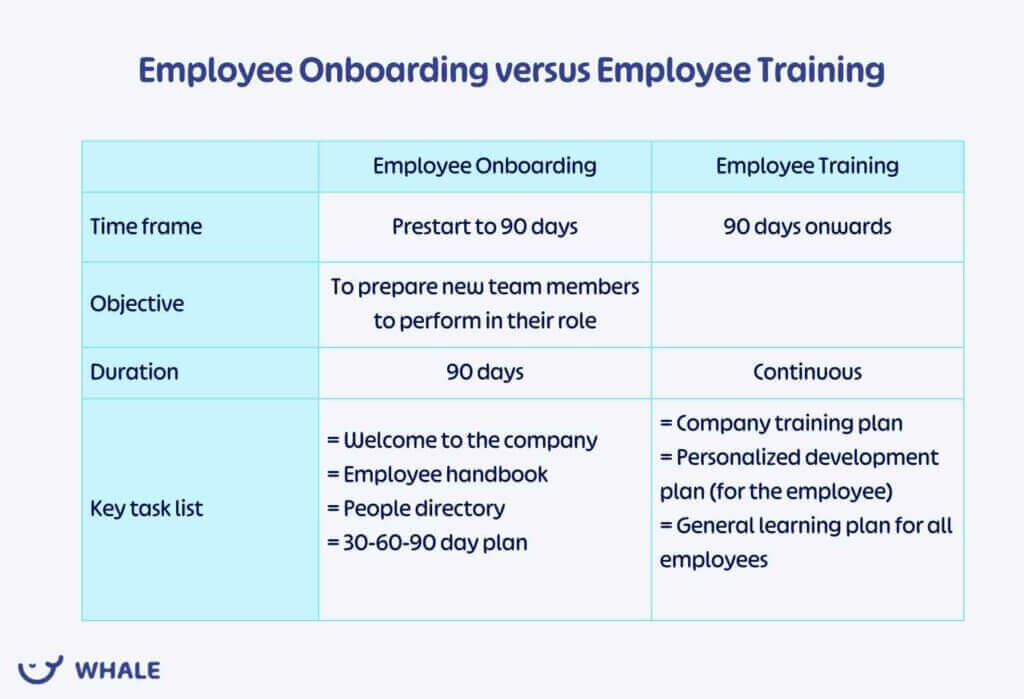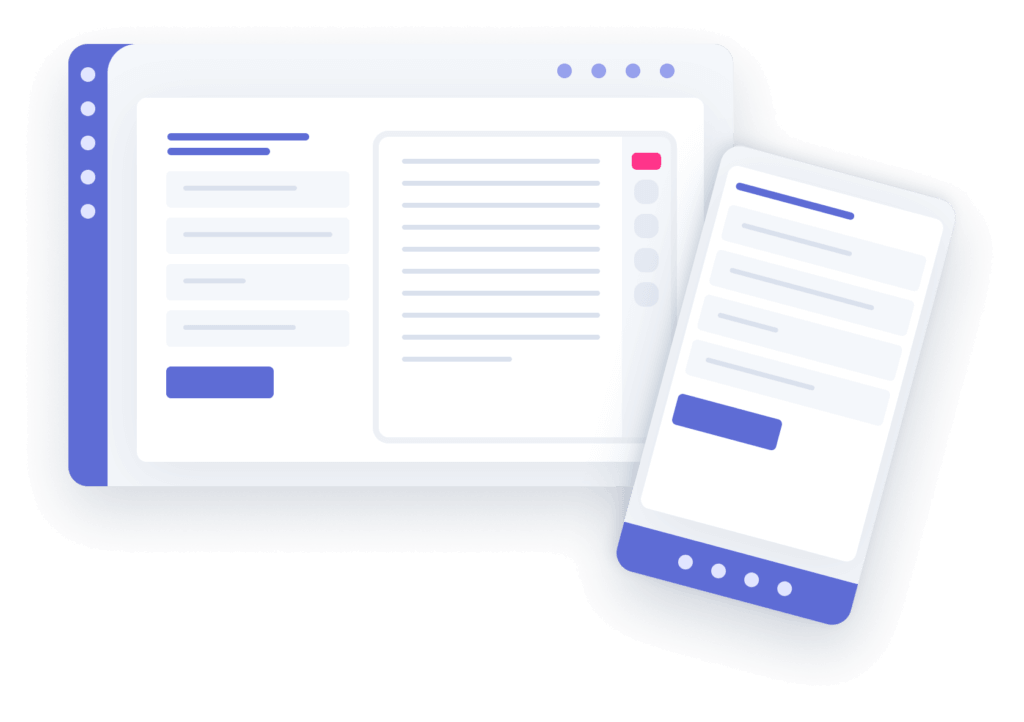What is the difference between Employee Onboarding and Training?
You’ve probably mapped out your customer journey. But what about your employee journey?
In the complex and busy world of human resources (HR) and organizational development, there are two absolutely standout components that make all the difference when it comes to success: employee onboarding and training.
While these two elements are often intertwined, they serve completely different purposes in your employee’s journey, and getting them both right is the first step towards happy and productive staff, as well as a thriving business.
So, what are the differences and how can you perfect both? Let’s take a look.
What is employee onboarding?
Do you remember your first day at work?
Was it great? Was it terrible? Well, that’s employee onboarding.
Employee onboarding is the welcoming portal into an organization – the initial step where a new employee is introduced to the company, its culture, and their role within it.
Learning is a crucial element to anyone’s working life, no matter where they are in their career. This is never more true than when someone first starts at a company.
Onboarding isn’t just about completing paperwork or receiving a desk; it’s an immersive experience designed to help new hires get cozy in their new company’s environment. In fact, according to a survey by CareerBuilder and Silk Road, 93% of employers agree a good onboarding experience is critical to influence a new hire’s decision in staying with the organization.
In contrast, only 12% of employees agree that their organization has a good onboarding process (Gallup), showing there is a huge opportunity for improvement for most businesses.
There are a variety of purposes when it comes to the onboarding process, and while these may differ slightly from company to company, the overarching theme is giving them the time to understand the company’s ethos and make them feel welcome and part of the team.
Components of onboarding can include:
- Orientation sessions
- Introductions to team members
- Company Policies
- The Employee Handbook
- Administrative procedures
Typical onboarding is broken up into a 30-60-90 day plan. This is because the first 90 days for any new hire will set a key foundation for the rest of their time at the organization.
Meighan Newhouse, CEO and Co-Founder at Inspirant Group, in her article on Forbes discusses how important a lengthy and structured onboarding process can be in business.
She states, “Many times, company onboarding is merely providing an overview of benefits, an intro to technology and handing out ID cards. For an onboarding program to be effective and successful, you should proactively onboard your new hires for their entire first year.

What is employee training?
While the onboarding process is an essential aspect to getting a new hire up to speed in the workplace, this is by no means where their learning should end.
Employee Training should be offered to employees after the 90 days initial period of onboarding is over. Training begins and should continue throughout their time within the business.
Training helps you and team members in several ways, such as:
Skills
Training is the secret ingredient to leveling up your team’s skills. It’s all about arming them with the tools they need to grow and adapt in the workplace.
Engagement
A good training program gets your team excited about their work. With engaging training, you can turbo-charge their enthusiasm and give them the confidence to take on more.
Retention
Training is a great way to keep your staff engaged and happy in their job. When they feel at home in their job, they’re more likely to stick around. Read more about how you can keep top talent within your team.
Culture
Good training brings about good culture. It’s the heart and soul of building a tight-knit crew in your business.
Results
According to the Association for Talent Development (ATD), companies that offer comprehensive training programs have a 218% higher income per employee than companies without formalized training. Additionally, they also enjoy a 24% higher profit margin than those who spend less on training. That’s ALOT!
The way you choose to provide training for your employees is completely up to you, and can be dependent on the topic, or the preferred method of learning. You might think about:
- Automated learning
- Workshops
- Mentoring
- Hands-on practical experiences
What are the key differences between employee onboarding and training?
The biggest and most obvious differences between onboarding and training lie in their objectives and timelines.
Onboarding starts from before the new team member joins up until 90 days of their tenure.
The onboarding process starts immediately after an employee begins at the company, serving as an adjustment and settling-in phase. Its focus is on integration, aligning the individual with the company’s values and operational processes.
On the other hand, training is an ongoing process designed to continuously develop an employee’s skills. Its focus is skill enhancement, fostering growth and proficiency in various areas and helping them to complete their role to their best abilities throughout their time with the company.
Another distinguishing factor is the methodologies that are used for each. Onboarding often involves more immersive experiences, interactive sessions, and sharing information to help the new hire familiarize themselves with the company, its people and the overall ethos.
Training, however, is usually more structured and focused on the acquisition of specific skills, often through dedicated sessions or programs.
While these processes differ in their focus and immediate goals, they are intrinsically linked. In a nutshell, a good onboarding process sets the stage for becoming a member of the team, and continuous training then builds up their skillset.
The importance of employee onboarding and training
The significance of both onboarding and training cannot be overstated. A solid onboarding process really sets out an employee’s whole journey within a company. It affects how engaged they are, how much they enjoy their job, and how likely they are to stick around for the long haul.
At the same time, training is a big deal for employee growth. It’s all about boosting skills, which then amps up performance, productivity, and job satisfaction. A team that’s well-trained isn’t just efficient but also more adaptable to changes and innovations in the industry.
Still, think it’s a waste of time to invest in onboarding and training? Here are a few reasons why it’s worth it;
- Smooth Integration: Onboarding helps new employees integrate smoothly into the workplace. It familiarizes them with the company culture, policies, and expectations, reducing the time it takes for them to become productive members of the team.
- Productivity and Performance: Proper training ensures that employees have the necessary skills and knowledge to perform their roles effectively. This leads to increased productivity and improved job performance.
- Employee Engagement: Onboarding and training contribute to higher levels of employee engagement. When employees feel confident and competent in their roles, they are more likely to be engaged and satisfied with their work.
- Retention levels: Investing in onboarding and training programs can positively impact employee retention. Employees who receive proper training are more likely to stay with the company, reducing turnover costs.
- Team Collaboration: Onboarding fosters team collaboration by introducing new employees to their colleagues and helping them build relationships within the organization. This is particularly important for creating a positive and inclusive work environment.
- Cost Savings: While there is an initial investment in onboarding and training, it can lead to long-term cost savings. Well-trained employees are more efficient, make fewer errors, and require less supervision.
This isn’t to mention the increase of levels of innovation, brand reputation, mitigation of risk and increase in general employee satisfaction and employee experience.
How to introduce effective onboarding and training programs for your business
I think we can all agree that there’s no point in going to the effort of bringing in new onboarding and training programs if they’re not going to be effective. And there’s nothing more frustrating than being an employee at a company that doesn’t put time and effort into making sure their staff have all the resources they need to do their job!
Here are some absolute musts when it comes to getting the most out of both of these processes.
1. Create checklists
For the onboarding process especially, the very first step is to prepare checklists of everything that you want to include during the program, ensuring that you think of every different step a person will go through on their journey. Take a look at some of the most common gaps in employee onboarding programs and how you can avoid them. This is also relevant for training, making sure you have a good understanding of the different training needs that each role or department will need.
2. Set your goals
For each stage of your onboarding process, or for whatever form of training you’re wanting to implement, it’s really important to set goals for what you want to achieve.
This will generally be related to the result you want, for example, on the first day of someone’s employment with your business, your goal may be to ensure your new hire feels welcomed and appreciated. Or if you’re implementing intermediate training on a new tool or system, your goal could be for the attendee to come away with a full knowledge of how to use it in relevance to their role.
3. Speak to your team and get feedback
One of the best ways to ensure you’ve incorporated everything you need to is to speak to staff at all different tenures and levels to get an understanding of what they particularly liked during their onboarding and training processes, and which areas they feel could be improved upon. This could be done through an employee survey, or as an informal question through their manager.
4. Get support across the business
It’s important to get support from top-level management throughout the process, letting them champion any new initiatives and cascade them through the business. When leaders actively participate and promote these programs, it can really help to reinforce their importance and ensure they’re used effectively going forward.
5. Use diverse methods
No matter what kind of industry you’re in or who your staff are, the most important thing is to ensure your onboarding and training processes are engaging.
No one wants to sit at a desk for hours on end reading long and complex documentation, so the more you can bring your onboarding and training programs to life, the more people will be able to absorb the information – and maybe even enjoy the process!
Utilize the Netflix Effect to make training engaging. Mix online learning with workshops, seminars, e-learning modules, and mentorship programs.
6. Measure and evaluate
Finally, no matter how good you think your onboarding or training processes are, it’s absolutely vital that you continuously measure their effectiveness and ask for feedback wherever possible, helping you to highlight any areas for improvement. This will also help to fine-tune each process and deliver the best results for your business.
How to address issues and challenges?
As with any new process, issues and challenges can arise when implementing updated onboarding or training structures. But this shouldn’t be seen as any sort of failure – more an opportunity to bring in even more improvements.
The key to tackling these challenges is being adaptable and flexible. When bumps show up in onboarding, like a disconnect between the real company culture and the one that’s portrayed, it’s crucial to make sure there are opportunities for staff to provide feedback. Regularly tweaking and refining the process will help to keep things on track.
As for training, if sticking to old-school methods is putting a damper on effectiveness, the answer is to shake things up. Introduce new technologies, give your content a makeover, or throw in some interactive elements to give your training programs a much-needed makeover.
To conquer these challenges, it’s all about keeping an eye on things, talking openly, and being ready to switch things up.
That way, both onboarding and training stay on point and can make a real impact.
Get started now: How Whale can help you build your onboarding and training programs in just a few minutes
Employee onboarding and training are the building blocks of any organization’s success. Even though they have different focuses and scopes, they team up to build a workforce that not only fits seamlessly into the company culture but also keeps growing and learning.
If you’re looking for a new and efficient way to improve your company’s organization – we have just the tool for you. Whale is the fastest documentation and training tool on the market, helping to get everyone in your business on the same page.
With AI assisted procedure and policy writing, ready-to-use templates and an intuitive editor at your fingertips, it’s never been easier to centralize all of your internal knowledge into one place.
FAQs about the difference between employee onboarding and training
What is the difference between employee orientation and employee training?
Orientation is a broad introduction to the company, designed to immerse new hires into the culture and workflows. On the other hand, training is more focused, offering detailed, role-specific guidance to equip employees with the skills they need for their particular job. Both are essential for a smooth onboarding experience, but each serves a unique purpose in setting employees up for success.









